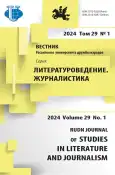Old radio in new guise: understanding relevance of amateur/ham radio in India
- 作者: Mukherjee A.1, Chattopadhyay P.2, Moreva A.N.3,4
-
隶属关系:
- University of Calcutta
- University of Kalyani
- Moscow State Linguistic University
- RUDN University
- 期: 卷 29, 编号 1 (2024)
- 页面: 125-134
- 栏目: JOURNALISM
- URL: https://journal-vniispk.ru/2312-9220/article/view/319232
- DOI: https://doi.org/10.22363/2312-9220-2024-29-1-125-134
- EDN: https://elibrary.ru/GEZBVX
- ID: 319232
如何引用文章
全文:
详细
Development of information and communication technology in India has reached a new height with the successful landing of Chandrayan-3 to moon in August 2023. In such a developed milieu of communication, otherwise seen as obsolete medium of communication, amateur radio must be revisited and seen in the context of their present form of activities in India. Ham radio organizations are present in almost all countries of the world, but it was mainly seen as a means of communication in a pre-digital world. Ham radio organizations in Indian society with their exemplary activities in the resent millennium seems to be the silent servers of society cutting across communities without much media or academic attention as compared to community radio organizations which caters to specific communities with specific goals. The study aims to highlight such untapped potential of ham radio in Indian society which can be used as an alternative communication channel in emergency situations. It is concluded by arguing that ham radio resonates the spirit of logic, logistics and language of new digital media era and can be seen as a balanced communication form between old media and new media era.
作者简介
Arunima Mukherjee
University of Calcutta
Email: arunimamukherjee2009@gmail.com
ORCID iD: 0009-0003-7410-2528
lecturer, doctoral student in journalism, Department of Journalism and Mass Communication, Gurudas College
1/1 Suren Sarkar Rd, Kolkata, West Bengal, 700054, Republic of IndiaPratip Chattopadhyay
University of Kalyani
Email: chatterjee23_pratip@yahoo.co.in
ORCID iD: 0000-0002-9380-7115
PhD (Political Science), Associate Professor and Head Department of Political Science
Kalyani, Nadia, 741235, West Bengal, Republic of IndiaAnna Moreva
Moscow State Linguistic University; RUDN University
编辑信件的主要联系方式.
Email: annseasoul@gmail.com
ORCID iD: 0009-0006-3404-285X
curator and author of the training program of the Russian-Indian project of the Moscow State Linguistic University and the Indian Institute of Social Security and Business Management (Kolkata), senior lecturer, Department of Communication Technologies, Deputy Director for Project Activities and Media Communications, Institute of International Relations and Social and Political Sciences, Moscow State Linguistic University; lecturer, Department of Mass Communications, Faculty of Philology, RUDN University
38 Ostozhenka St, Moscow, 119034, Russian Federation; 6 Miklukho-Maklaya St, Moscow, 117198, Russian Federation参考
- Barlett, R.A. (2015). The world of ham radio, 1901-1950: A social history. London: McFarland & Co Inc.
- Bonni, T. (2014). The new role of media and its public in the age of social network sites. First Monday, 19(6). https://doi.org/10.5210/fm.v19i6.4311
- Bruns, A. (2007). Produsage: Towards a broader framework for user-led content creation. In B. Shneiderman (Ed.), Proceedings of 6th ACM SIGCHI Conference on Creativity and Cognition 2007 (pp. 99-105). Association for Computing Machinery, United States of America.
- Gurevitch, M., Coleman, S., & Blumler, J.G. (2009). Political communication - old and new media relationships. The ANNALS of the American Academy of Political and Social Science, 625(1), 164-181. https://doi.org/10.1177/0002716209339
- Kapur, G.B., Bezek, S., & Dyal, J. (Eds). (2017). Effective communication during disasters: Making use of technology, media, and human resources. New York: Apple Academic Press. https://doi.org/10.1201/9781315365640
- Konradova, N.A. (2022). The archaeology of the Russian Internet: Telepathy, teleconferencing and other Cold War techno-utopias. Moscow: Corpus Publ. (In Russ.)
- Kumar, H.V., Reddy, K.V.M., Reddy, B.S., Reddy K.N., & Reddy K.Y.K. (2020). Live streaming of agriculture market statistics to the remote village areas using amateur radio. International Journal of Innovative Science and Research Technology, 5(4), 1250-1252.
- Logvinov, V.V., & Smolskiy, S.M. (2022). Noise immunity of radio receivers. Radio Receivers for Systems of Fixed and Mobile Communications. Textbooks in Telecommunication Engineering. Cham: Springer. https://doi.org/10.1007/978-3-030-76628-3_4
- Malik, K., & Pavarala, V. (Eds.). (2020). Community radio in South Asia: Reclaiming the airwaves. London: Routledge India. https://doi.org/10.4324/9781003056232
- Mare, A. (2013). New media, pirate radio and the creative appropriation of technology in Zimbabwe: Case of radio voice of the people. Journal of African Cultural Studies, 25(1), 30-41. https://doi.org/10.1080/13696815.2012.749781
- Pavarala, V., & Malik, K. (2007). Other voices: The struggle for community radio in India. New Delhi: Sage.
- Rikitianskaia, M. (2017). How children learned to listen: The formation of radio clubs in the Soviet Union. Logos, 27(5), 141-162. (In Russ.)
- Servaes, J., & Malikhao, P. (2005). Participatory communication: The new paradigm? In O. Hermer & T. Tufte (Eds.), Media and Global Change: Rethinking Communication for Development (pp. 91-100). Gothenburg, Buenos Aires: Nordicom.
- Suri, S. (2019). All about ham radio. New Delhi: BUUKS.
- Wadhwa, M., Xin, C., Song, M., Diawara, N., Zhao, Y., & Kaur, K. (2012). Optimal spectrum sharing for contention-based cognitive radio wireless networks. In X. Wang, R. Zheng, T. Jing & K. Xing (Eds.), Wireless Algorithms, Systems, and Applications. WASA 2012. Lecture Notes in Computer Science (vol. 7405). Berlin, Heidelberg: Springer. https://doi.org/10.1007/978-3-642-31869-6_16
- Xu, X., Huang, A., Zhang, J., & Zheng, B. (2012). Bit allocation scheme with primary base station cooperation in cognitive radio network. In R.D. Deshpande (Ed.), Lecture Notes in Computer Science (pp. 178-186). Springer.
补充文件









